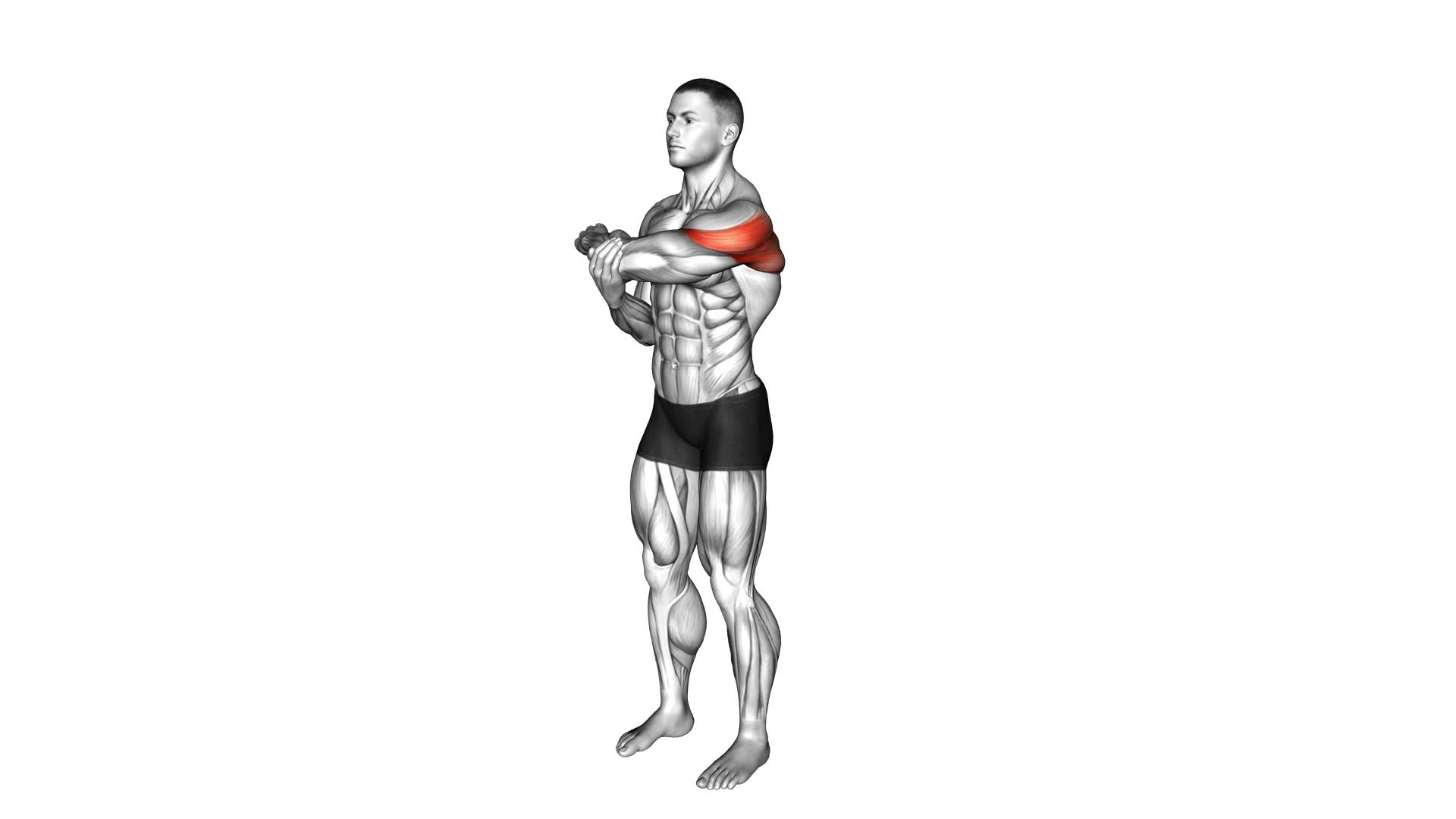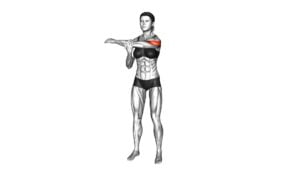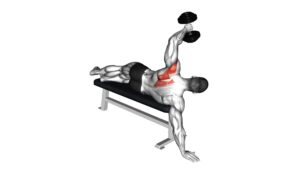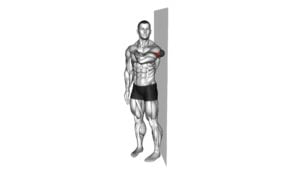Rear Deltoid Stretch – Video Exercise Guide & Tips

Looking to improve your rear deltoids? Check out this video exercise guide for the rear deltoid stretch.
Watch This Exercise Video
In just a few minutes, you'll learn how to properly perform this stretch and get the most out of your workout.
Avoid common mistakes and discover variations to suit your fitness level.
With helpful tips and clear instructions, you'll be on your way to stronger and more flexible rear deltoids in no time.
Let's get started!
Key Takeaways
- The rear deltoid stretch improves shoulder mobility and flexibility.
- It helps prevent injuries and stabilizes the shoulder joint.
- The stretch reduces the risk of strains, tears, and shoulder-related issues.
- It enhances athletic performance and everyday activities.
Benefits of the Rear Deltoid Stretch
One benefit of the rear deltoid stretch is that it improves your shoulder mobility and flexibility. Stretching the rear deltoids is important because it helps prevent injuries. The rear deltoid muscles are located at the back of your shoulders and play a vital role in stabilizing the shoulder joint.
When these muscles are tight or restricted, it can lead to imbalances and limited range of motion, making you more prone to shoulder injuries. By regularly performing the rear deltoid stretch, you can increase the flexibility and mobility of these muscles, reducing the risk of strains, tears, and other shoulder-related issues.
This stretch specifically targets the rear deltoids, helping to elongate and relax the muscles, allowing for greater freedom of movement in the shoulder joint. Additionally, improved shoulder mobility and flexibility can enhance your overall athletic performance and make everyday activities easier and more comfortable.
Incorporating the rear deltoid stretch into your fitness routine is a simple yet effective way to maintain healthy, injury-free shoulders.
How to Properly Perform the Rear Deltoid Stretch
To properly perform the rear deltoid stretch, you should regularly and gently stretch the muscles at the back of your shoulders. Here are four steps to help you achieve the proper form for this stretch:
- Stand straight with your feet shoulder-width apart.
- Extend your right arm straight out in front of you at shoulder height.
- Take your left arm and cross it over your body, placing your left hand on your right elbow.
- Gently pull your right arm towards your body, feeling a stretch in the back of your right shoulder.
It's important to maintain proper form during the rear deltoid stretch to avoid common mistakes and ensure effectiveness. Keep the following tips in mind:
- Avoid jerking or pulling too forcefully, as this can strain the muscles.
- Gradually increase the intensity of the stretch over time, rather than forcing it all at once.
- Breathe deeply and relax your body to enhance the stretch and prevent tension.
- If you feel any pain or discomfort, stop immediately and consult with a healthcare professional.
By following these guidelines for proper form, you can maximize the benefits of the rear deltoid stretch while minimizing the risk of injury.
Now let's explore some common mistakes to avoid during this exercise.
Common Mistakes to Avoid During the Rear Deltoid Stretch
To avoid common mistakes during the rear deltoid stretch, focus on maintaining proper form and avoiding excessive force.
One common mistake is rounding your shoulders forward instead of keeping them relaxed and pulled back. This not only reduces the effectiveness of the stretch but also puts unnecessary strain on your neck and upper back. To avoid this, imagine squeezing your shoulder blades together as you perform the stretch.
Another mistake is using too much force or pulling too hard on your arm. Remember, the goal is to gently stretch the rear deltoid muscle, not to force it into an uncomfortable position. Start with a light stretch and gradually increase the intensity if needed.
Lastly, be mindful of your breathing. Holding your breath during the stretch can lead to tension and muscle tightness. Instead, inhale deeply before starting the stretch and exhale slowly as you ease into the position.
Tips for Getting the Most Out of Your Rear Deltoid Stretch
To maximize the benefits of your rear deltoid stretch, it's important to focus on proper form and technique. Here are some tips to help you get the most out of this stretch and improve your flexibility:
- Warm up before stretching: Engage in some light cardio exercises, such as jogging or jumping jacks, to increase blood flow and warm up your muscles before performing the rear deltoid stretch.
- Maintain proper posture: Stand tall with your feet shoulder-width apart and keep your core engaged. Avoid slouching or rounding your shoulders during the stretch to ensure optimal engagement of the rear deltoid muscles.
- Gradually increase the stretch: Start by gently stretching your rear deltoids and gradually increase the intensity of the stretch over time. Avoid forcing the stretch and listen to your body's limits.
- Incorporate the rear deltoid stretch into your workout routine: Aim to perform the rear deltoid stretch at least two to three times a week to improve flexibility and prevent muscle imbalances. You can incorporate it before or after your upper body workouts.
Variations and Modifications for the Rear Deltoid Stretch
To modify the rear deltoid stretch, you can incorporate different variations that target specific areas of the muscles. These modifications can help you customize the stretch to your individual needs and goals.
One variation you can try is the standing rear deltoid stretch. To do this, stand with your feet shoulder-width apart and reach your arms straight out in front of you. Then, cross one arm over the other and grab onto the opposite elbow. Gently pull your arms towards your chest, feeling a stretch in the back of your shoulders.
Another modification is the seated rear deltoid stretch. Sit on the edge of a chair and reach your arms behind you, placing your hands on the backrest. Slowly lean forward, feeling a stretch in your rear deltoids.
Additionally, you can use a resistance band to modify the rear deltoid stretch. Simply hold one end of the band in each hand and stretch your arms out in front of you. Then, pull the band apart, feeling a stretch in your rear deltoids.
These variations and modifications allow you to target different areas of the muscles and customize your stretch routine.
Frequently Asked Questions
What Is the Recommended Frequency for Performing the Rear Deltoid Stretch?
The recommended frequency for performing the rear deltoid stretch depends on your individual needs and goals. However, it's generally recommended to stretch the rear deltoid muscles at least two to three times a week to maintain flexibility and prevent shoulder pain.
Regularly stretching these muscles can help improve range of motion and reduce the risk of injury. It's important to listen to your body and adjust the frequency accordingly to avoid overstretching or causing further discomfort.
Can the Rear Deltoid Stretch Help Alleviate Shoulder Pain or Discomfort?
The rear deltoid stretch can be beneficial in alleviating shoulder pain or discomfort. By stretching the rear deltoid muscle, you can improve flexibility and range of motion in your shoulders. This can help to reduce tension and tightness in the muscles, relieving any pain or discomfort you may be experiencing.
There are also variations of the rear deltoid stretch that can target different areas of the shoulder, providing additional benefits.
Are There Any Specific Precautions or Contraindications for Performing the Rear Deltoid Stretch?
When performing the rear deltoid stretch, it's important to be aware of any specific precautions or contraindications. These can vary depending on individual circumstances, so it's best to consult with a healthcare professional or certified trainer.
They can assess your specific needs and provide guidance on how to safely perform the exercise without causing any further discomfort or injury.
What Other Exercises or Stretches Can Complement the Rear Deltoid Stretch for a Well-Rounded Shoulder Routine?
To complement the rear deltoid stretch and create a well-rounded shoulder routine, there are a variety of exercises and stretches you can try.
Some great options include shoulder presses, lateral raises, and bent-over rows. These exercises target different areas of the shoulder and can help to strengthen and tone the muscles.
Additionally, incorporating stretches like the shoulder crossover stretch and the shoulder extension stretch can further increase flexibility and range of motion in the shoulder joint.
Is It Necessary to Warm up Before Performing the Rear Deltoid Stretch, and if So, What Warm-Up Exercises Are Recommended?
Before performing the rear deltoid stretch, it's important to warm up your muscles to prevent injury. Engaging in warm-up exercises increases blood flow to the muscles and prepares them for stretching. Some recommended warm-up exercises include arm circles, shoulder rolls, and light shoulder presses.
Warming up not only helps prevent injury, but it also enhances the benefits of stretching by increasing flexibility and range of motion in the shoulders.
Conclusion
In conclusion, the rear deltoid stretch is a beneficial exercise for stretching and strengthening the muscles in the back of the shoulders.
By following the proper technique and avoiding common mistakes, you can maximize the effectiveness of this stretch.
Additionally, incorporating variations and modifications can provide different levels of intensity and target specific areas.
Remember to always listen to your body and consult with a professional if you have any concerns or injuries.

Author
Years ago, the spark of my life’s passion ignited in my mind the moment I stepped into the local gym for the first time. The inaugural bead of perspiration, the initial endeavor, the very first surge of endorphins, and a sense of pride that washed over me post-workout marked the beginning of my deep-seated interest in strength sports, fitness, and sports nutrition. This very curiosity blossomed rapidly into a profound fascination, propelling me to earn a Master’s degree in Physical Education from the Academy of Physical Education in Krakow, followed by a Sports Manager diploma from the Jagiellonian University. My journey of growth led me to gain more specialized qualifications, such as being a certified personal trainer with a focus on sports dietetics, a lifeguard, and an instructor for wellness and corrective gymnastics. Theoretical knowledge paired seamlessly with practical experience, reinforcing my belief that the transformation of individuals under my guidance was also a reflection of my personal growth. This belief holds true even today. Each day, I strive to push the boundaries and explore new realms. These realms gently elevate me to greater heights. The unique combination of passion for my field and the continuous quest for growth fuels my drive to break new ground.







